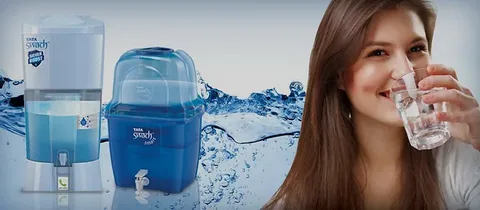In today’s society, access to clean and safe drinking water is essential for maintaining good health. A reliable water purifier can significantly enhance the quality of water you consume, providing peace of mind for you and your family. Various contaminants, such as bacteria, viruses, heavy metals, and chemicals, can be present in tap water, making it crucial to choose the right purification system to address these issues.
Water purifiers come in a range of types, each with distinct mechanisms and benefits. From reverse osmosis systems that remove heavy metals to ultraviolet purifiers that eliminate microorganisms, the options are diverse. Activated carbon filters are well-regarded for their ability to improve taste and remove chlorine, while distillation units effectively rid water of both impurities and minerals by converting it to steam and back to liquid.
Choosing the Best Water Purifier involves understanding your household’s specific needs and the quality of water in your area. Factors such as the number of people in your home, daily water consumption, and budget all play a role in making an informed decision. Additionally, considering the ease of maintenance, energy consumption, and durability of the purifier can help you select a model that suits your lifestyle.
By exploring the different types of water purifiers and their features, you can make an educated choice, ensuring you have access to pure and safe drinking water.
Types of Drinking Water Filter
Understanding the different types of Drinking Water Filter can assist you in making an informed decision.
Reverse Osmosis:
This method utilizes a semi-permeable membrane to remove impurities, effectively eliminating contaminants like lead, chlorine, and fluoride. It’s one of the most comprehensive filtration systems available, ideal for areas with highly contaminated water.
Ultraviolet Purification:
Employing UV light, this technique kills bacteria, viruses, and other pathogens, making it a great choice for ensuring microbiologically safe water. It does not remove chemicals or physical impurities, so it is often used in conjunction with other filters.
Activated Carbon Filters:
These filters are known for their ability to improve taste and odour by absorbing organic compounds and chlorine. They are effective in removing pesticides and herbicides but are less capable of filtering out heavy metals and dissolved solids.
Distillation
This process involves boiling water and then condensing the steam back into liquid form, effectively removing a wide range of impurities, including bacteria, viruses, and minerals. It is highly effective but tends to be slower and may consume more energy compared to other methods.
Each type of water filter has its own advantages and specific applications, making it important to choose based on your particular needs and water quality concerns.
Choosing the Right Water Purifier
Choosing the best water purifier involves evaluating several factors specific to your needs and circumstances. Begin by determining the water quality in your area. Conduct a water test to identify contaminants present, such as heavy metals, chlorine, or microorganisms. This initial step will help you understand which type of purifier will be most effective.
Next, consider the requirements of your household. The size of your family and daily water consumption plays a significant role in selecting a suitable purifier. For larger households, a purifier with a high filtration rate is necessary to ensure an adequate supply of clean water. Smaller households may manage well with a less powerful unit.
Budget is another critical aspect. While the initial purchase price is important, don’t overlook ongoing costs such as filter replacements and potential maintenance. It’s wise to choose a model that offers a balance between cost and functionality.
Additionally, examine the ease of maintenance. Some purifiers have filters that are straightforward to replace and require minimal upkeep, while others might be more complex. Energy consumption is also a factor; opting for an energy-efficient model can help keep your utility bills manageable.
Lastly, the durability of the purifier should be considered. Look for models with strong warranties and positive customer reviews, ensuring long-term reliability and customer support.
Features to Look for in a Water Purifier
When selecting a water purifier, key features can greatly impact its performance and user satisfaction. Consider the filtration rate to ensure it meets your household’s water demand without compromising on quality. Ease of maintenance is crucial; opt for models with filters that are easy to replace and require minimal upkeep. Energy consumption is another important factor; energy-efficient models not only save on electricity bills but also have a lower environmental footprint. Durability should also be evaluated—choose a purifier known for its robust construction and reliable operation. Lastly, consider the availability of customer support and the length and coverage of the warranty to protect your investment.
Installation and Maintenance
Proper installation and maintenance are vital for ensuring your water purifier functions efficiently and delivers safe drinking water.
For installation, always refer to the manufacturer’s manual for detailed instructions. Typically, this involves mounting the purifier in a suitable location, connecting it to your water supply, and ensuring all seals and connections are secure to prevent leaks. Some models may require additional steps, such as flushing the system before use or calibrating settings.
Routine maintenance is crucial for optimal performance. Regularly replacing filters as recommended by the manufacturer is key. Most purifiers have indicator lights or reminders to notify you when it’s time for a change. Additionally, periodically clean the external parts of the unit with a damp cloth to prevent dust and grime build-up.
Addressing common issues promptly can prevent bigger problems. If you notice a decrease in water flow, unusual tastes, or any leaks, check the troubleshooting section of your manual. Often, these issues can be resolved by replacing a filter or tightening a connection.
For advanced models, it might be necessary to run self-cleaning cycles or replace UV lamps periodically. Always follow the manufacturer’s guidance to ensure you’re maintaining the purifier correctly.
By following these steps, you can extend the lifespan of your water purifier and ensure it consistently provides clean, safe drinking water.
Benefits of Using a Water Purifier Filter
A Water Purifier Filter offers numerous advantages for both health and convenience. One of the primary benefits is the removal of harmful contaminants such as bacteria, viruses, heavy metals, and chemicals, ensuring that the water you consume is safe and healthy. This can lead to improved overall health and a reduced risk of waterborne diseases.
Another significant advantage is the enhancement of taste and odor. Many water sources contain chlorine and other chemicals that can affect the flavor and smell of water. A good quality purifier filter can effectively eliminate these substances, resulting in water that is more pleasant to drink.
Using a water purifier filter is also environmentally friendly. By reducing reliance on bottled water, you can significantly cut down on plastic waste, contributing to a cleaner environment. This not only saves money but also supports sustainability efforts.
Convenience is another key benefit. With a water purifier, you have access to clean water directly from your tap, eliminating the need to purchase and transport bottled water. This can be particularly beneficial for large households or those living in areas where access to bottled water is limited.
Lastly, modern water purifiers often come with advanced features such as indicator lights and automatic shut-off mechanisms, making them easy to maintain and ensuring they operate efficiently.
Customer Reviews and Ratings
Customer reviews and ratings are invaluable when selecting a water purifier, as they offer insights into real-world performance and user satisfaction. When analyzing feedback, pay attention to comments regarding ease of installation and maintenance, as these factors can significantly affect your experience. Look for reviews that discuss the effectiveness of the purifier in removing specific contaminants like chlorine, lead, or bacteria.
Additionally, feedback on the taste and odor of the purified water, as this can vary between different models and types of filters, should be considered. Users often highlight the longevity of filters and the frequency of replacements, which can influence ongoing costs.
It’s also useful to read about any issues encountered, such as leaks or decreased water flow, and how these were resolved. Positive reviews that mention responsive customer service and effective troubleshooting can be reassuring, indicating that the brand offers good support.
Finally, high ratings often correlate with features like energy efficiency, advanced filtration technologies, and overall reliability. By taking these reviews into account, you can make a more informed decision and choose a water purifier that best fits your needs and expectations.
Conclusion
The ongoing advancements in water purification technology provide households with increasingly sophisticated options for ensuring clean and safe drinking water. Modern purifiers are not only more efficient but also more user-friendly, offering features like real-time monitoring and automatic maintenance reminders. With a variety of models available, consumers can find solutions tailored to specific needs, whether it’s a high-capacity system for large families or a compact unit for smaller households. Additionally, the focus on energy efficiency and sustainability means that today’s purifiers are designed to minimize environmental impact while delivering high-quality water. The availability of detailed customer reviews and ratings also aids in making informed decisions, ensuring that you invest in a purifier that meets your expectations and offers long-term reliability.
FAQS
1. How often should I replace with the Best Water Purifier?
– The frequency of filter replacement depends on the specific model and usage, but generally, it ranges from every 6 to 12 months. Always refer to the manufacturer’s guidelines for the best results.
2. Can a water purifier remove all contaminants?
– While most water purifiers are designed to tackle a broad spectrum of contaminants, no single purifier can remove every type. It’s important to choose a system that targets the specific impurities found in your water supply.
3. Do water purifiers waste a lot of water?
– Some systems, particularly reverse osmosis units, can produce wastewater as a by-product of the filtration process. However, newer models are designed to be more efficient, reducing the amount of waste produced.
4. Is professional installation required?
– Many water purifiers, especially simpler models like activated carbon filters or UV purifiers, can be installed by the user. More complex systems, such as those involving reverse osmosis, may benefit from professional installation to ensure optimal performance and safety.
5. How do I know if my purifier is working effectively?
– Regular water testing is the most reliable way to verify the effectiveness of your purifier. Additionally, adhering to the maintenance schedule, including timely filter replacements, ensures the system operates efficiently.
6. Are there any health risks with water purifiers?
– When maintained properly, water purifiers are generally safe and beneficial for health. However, neglecting maintenance or improper use can lead to issues such as bacteria build-up, which can pose health risks. It’s crucial to follow the manufacturer’s maintenance recommendations to avoid such problems.
| Related Business Listings |
| Contact Directory |
| Local Business Profiles |




